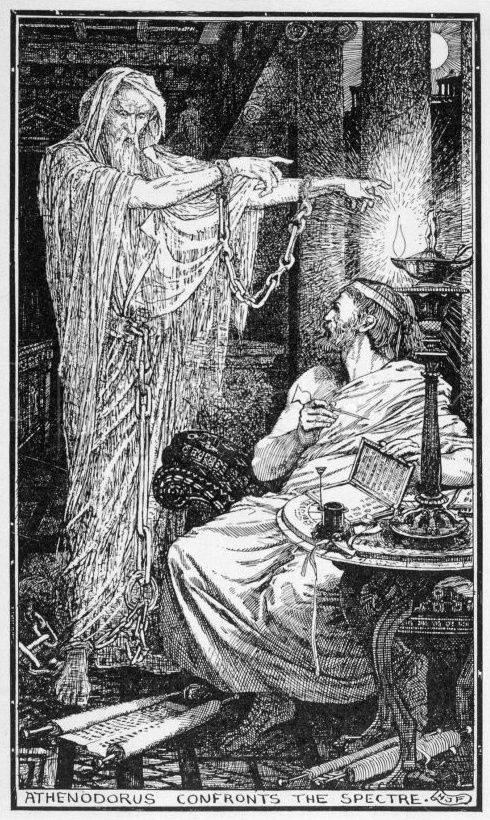a riveting ghost story from ancient greece

Today we celebrate Halloween, and since it’s a spooktacular time to share ghost stories, why not we talk about one right now? This story is from the land of the Stoics and it does come with some meaningful lessons so stay tuned for them at the end of the narrative.
. . .
In his letter To Sura, the ancient Roman writer Pliny the Younger recounts one of the oldest and most renowned ghost stories of all time.
Once there was a Stoic philosopher named Athenodoros of Tarsos. Upon arriving in Athens, Athenodoros discovered a spacious house for sale at an unusually low price. Inquiring about the reason for the bargain, he learned that every night, eerie chains clash in a specific room. Over time, the rattling of chains intensified, culminating in the chilling appearance of a gaunt, elderly figure, standing in the room with iron chains attached to his arms and dragging along on the floor behind him. This spectral man was described as emaciated, as if starved, with tangled and matted hair and beard.
Without hesitation, Athenodoros purchased the house. That night, he arranged his writing desk in the very room where the spectral apparition was rumored to manifest. In the initial hours, there was no trace of any supernatural occurrences. However, as the clock struck midnight, as foretold, Athenodoros could discern the unmistakable clashing of iron chains resonating from within the house. Undeterred, he paid no heed to the sound and persisted in his writing. Gradually, the clamor intensified, yet Athenodoros remained unfazed.

Eventually, the ghost materialized in the room, rattling chains and emitting mournful moans. Athenodoros, unfaltering, continued his writing, seemingly oblivious to the haunting presence. The eerie figure approached Athenodoros and gestured for him to follow.
This is where Athenodorus truly displayed his fortitude. He didn't succumb to fear, nor did he hastily escape the premises. There was no freezing in place, no immediate response to the ghostly encounter. Remarkably composed, Athenodorus merely raised his eyes to acknowledge the apparition and signaled for the spirit to be patient while he completed his writing. The ghost, after some time, rattled its chains directly in Athenodoros’ face to draw his attention and made the sign indicating for him to follow once again. The man didn’t budge.
At last, Athenodoros rose from his seat, took up his lamp, and followed after the apparition. The spectral figure guided Athenodoros to the courtyard, positioned itself over a specific spot, and then dissipated into nothingness. Athenodoros meticulously marked the location where the ghost had vanished with leaves, patiently awaiting the break of dawn. Come morning, he contacted the authorities, urging them to excavate the spot of the ghost's disappearance. Upon excavation, they uncovered the skeleton of a man with iron chains around his wrists—a somber testament to the unmarked resting place that had endured for many years.
As per Athenodoros's request, the skeleton received a public funeral with full honors. Following that solemn occasion, the ghost never made another appearance.
. . .
The story of Athenodorus and the haunted house imparts several lessons:
- Courage in the Face of Fear: Athenodorus demonstrates remarkable courage by willingly entering a haunted house despite the warnings. This teaches us the importance of facing our fears head-on, especially when motivated by a higher purpose or curiosity.
- Rationality and Stoicism: Athenodorus, being a Stoic philosopher, approaches the situation with reason and composure. The story illustrates the Stoic principles of maintaining inner calm and using rationality to confront challenges. It suggests that a clear and logical mind can overcome even supernatural fears.
- Investigation and Understanding: Instead of succumbing to superstition, Athenodorus investigates the source of the haunting. This encourages a mindset of curiosity and a willingness to seek understanding even in the face of the unknown.
- Compassion: Athenodorus doesn't just dismiss the ghost but follows it to discover the cause of its unrest. This reflects compassion and a desire to help, reminding us of the importance of empathy in our interactions, even with the supernatural.
- Resolution through Action: The story concludes with a resolution to the haunting after proper burial is given to the discovered remains. This highlights the idea that proactive and meaningful action can bring closure to unresolved issues, both in the supernatural realm and in our everyday lives.
In essence, the story encourages us to be brave, rational, compassionate, and proactive, therefore a true Stoic, when confronted with challenges, whether they be of a supernatural nature or part of our ordinary experiences.
Happy Halloween everyone!
FUN FACT
Mary Shelley wrote Frankenstein when she was 18, during a ghost story competition while staying in Switzerland with writers Percy Shelley (her lover) and Lord Byron.


